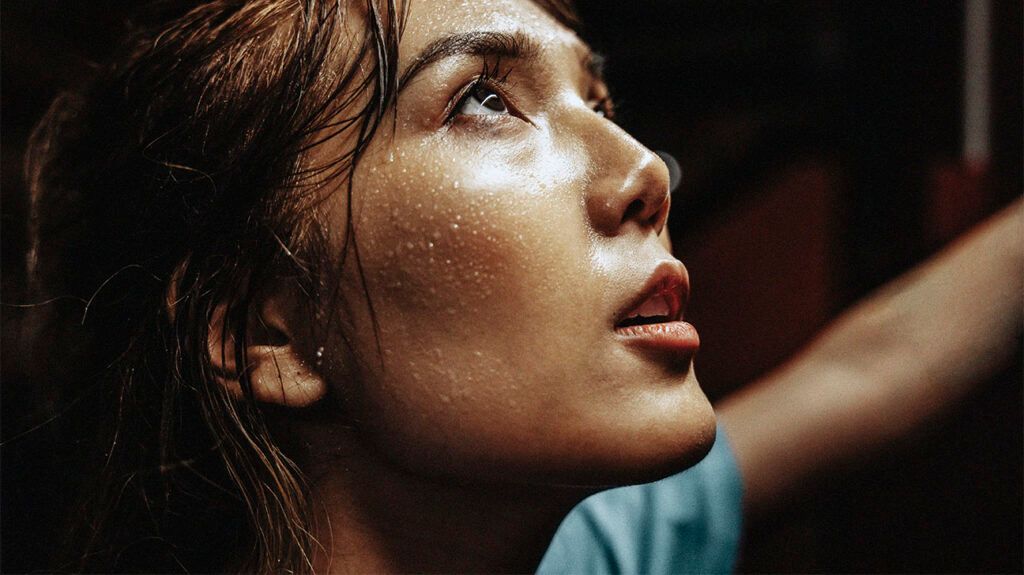While exercise itself does not cause acne, the buildup of sweat on the skin during a workout can allow bacteria to grow, which could inflame pores and cause acne.
Acne that occurs due to sweat may appear where sweat accumulates, such as on the back or chest. Alternatively, it could develop in places where the skin is in contact with sweaty clothing or exercise equipment.
People can take simple steps before, during, and after exercise to prevent sweat acne. This includes wearing clean, breathable fabrics, and showering immediately after a workout.
Keep reading to learn more about whether sweat causes acne, what sweat pimples look like, and whether working out reduces or causes acne. This article will also explain how to treat sweat-induced acne and other conditions that may resemble it.

According to a
Sweat can allow bacteria to grow, which is what causes body odor. If species of bacteria that cause acne grow in higher numbers, a person could get more acne. Sweat itself, along with dead skin and other debris, could possibly block pores.
Excessive sweating may also cause dysregulation of a substance known as dermcidin, which sweat and oil glands in the skin release. An older
Decreased levels of dermcidin may permit the bacteria that cause acne to multiply.
Sweat pimples look like other pimples, with a bump under the surface of the skin and a white center or “head” in the middle.
As with more general acne, pimples may occur anywhere on the body, but they may appear most in areas where sweat accumulates, such as on the chest or back.
Sweat-related acne could also develop where sweaty clothes sit tightly against the skin. For example, bra straps could lead to acne on the shoulders, while headbands could lead to forehead acne.
The act of exercising itself does not cause acne. However, the effects of exercise, which include increased sweating and the accumulation of dirt, oil, and bacteria on the skin, could trigger or worsen acne.
There is no evidence that sweating helps clear blocked pores.
The idea that sweating helps clear blocked pores comes from the belief that deliberately inducing sweating can force oil and dirt out of pores. No studies have proven this is possible. In fact, sweat may contribute to blocked pores.
Some people also believe sweating expels toxins and waste products from the body through sweat, which could reduce acne.
However, while sweat may play a role in removing waste products from the body,
Additionally, waste products and toxins excreted from the body through pores are also not the cause of acne.
Acne that only occurs as a result of sweating may go away on its own. Until it does, people can help the healing process by keeping the area clean and avoiding further inflammation. It may help to:
- use a gentle, pH-balanced cleanser when washing
- follow washing with an acne treatment, containing salicylic acid or benzoyl peroxide
- apply an oil-free moisturizer that will not clog pores
If this does not help or the acne does not go away, there may be another cause. A dermatologist can provide treatment advice if this is the case.
The best way to avoid sweat acne is to prevent it. People can take simple steps to reduce the likelihood of developing acne before, during, and after their workouts.
Before exercising, the American Academy of Dermatology Association (AAD) advises:
- removing makeup, since it can clog pores
- wearing clean, loose-fitting workout clothes in breathable fabrics
- applying oil-free sunscreen if exercising outside, since the sun dries the skin, which can lead to increased oil production
During exercise:
- use a clean towel to gently pat off sweat
- wipe down shared equipment before and after use to avoid contact with sweat from others
- avoid sharing protective gear, such as shoulder pads and helmets
After getting sweaty:
- remove clothes as soon as possible
- shower immediately in warm water, using a mild cleanser
- change into clean clothes and wash the dirty clothes
If a person cannot change and wash right away, they can use pads or wipes to remove sweat from their skin. People who are prone to acne may prefer to use wipes containing salicylic acid.
Conditions that may appear similar to sweat acne are below.
Heat rash
Heat rash is a
A heat rash can look and feel very similar to acne. Other terms for this condition include sweat rash or prickly heat.
Folliculitis
This is a
Aside from the scalp, folliculitis may manifest on the face, chest, back, arms, or legs.
Grover disease
Grover’s disease is a common type of itchy rash that usually appears as reddish-brown spots on sun-damaged parts of the skin, such as the neck, trunk, arms, or legs. Prolonged sun exposure is a potential risk factor, and it is more common in:
- males
- people over 50
- people with lighter skin
The condition is also known as transient acantholytic dermatosis.
For some, sweat may cause acne or make it worse. Dermatologists link sweating to the growth of bacteria on the skin, which can lead to acne. Sweat may also block pores or trap debris inside them.
Sweat-related acne looks the same as typical acne. It can occur anywhere but may appear in places where there is friction against the skin, such as beneath clothing straps or headbands.
Certain practices can help avoid acne worsening because of sweating. Wearing clean, moisture-wicking clothes, wiping shared equipment, and showering straight after exercise may all help.
If the acne does not get better, looks different than usual, or comes with other symptoms, a person should speak with a doctor.
